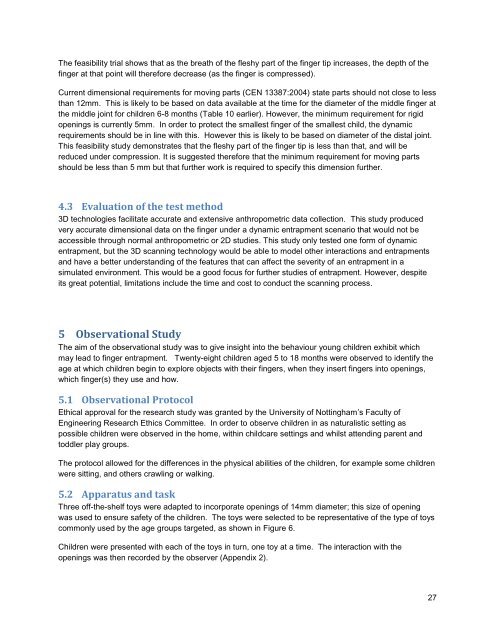Requirements for finger entrapment in European safety ... - ANEC
Requirements for finger entrapment in European safety ... - ANEC
Requirements for finger entrapment in European safety ... - ANEC
Create successful ePaper yourself
Turn your PDF publications into a flip-book with our unique Google optimized e-Paper software.
The feasibility trial shows that as the breath of the fleshy part of the <strong>f<strong>in</strong>ger</strong> tip <strong>in</strong>creases, the depth of the<br />
<strong>f<strong>in</strong>ger</strong> at that po<strong>in</strong>t will there<strong>for</strong>e decrease (as the <strong>f<strong>in</strong>ger</strong> is compressed).<br />
Current dimensional requirements <strong>for</strong> mov<strong>in</strong>g parts (CEN 13387:2004) state parts should not close to less<br />
than 12mm. This is likely to be based on data available at the time <strong>for</strong> the diameter of the middle <strong>f<strong>in</strong>ger</strong> at<br />
the middle jo<strong>in</strong>t <strong>for</strong> children 6-8 months (Table 10 earlier). However, the m<strong>in</strong>imum requirement <strong>for</strong> rigid<br />
open<strong>in</strong>gs is currently 5mm. In order to protect the smallest <strong>f<strong>in</strong>ger</strong> of the smallest child, the dynamic<br />
requirements should be <strong>in</strong> l<strong>in</strong>e with this. However this is likely to be based on diameter of the distal jo<strong>in</strong>t.<br />
This feasibility study demonstrates that the fleshy part of the <strong>f<strong>in</strong>ger</strong> tip is less than that, and will be<br />
reduced under compression. It is suggested there<strong>for</strong>e that the m<strong>in</strong>imum requirement <strong>for</strong> mov<strong>in</strong>g parts<br />
should be less than 5 mm but that further work is required to specify this dimension further.<br />
4.3 Evaluation of the test method<br />
3D technologies facilitate accurate and extensive anthropometric data collection. This study produced<br />
very accurate dimensional data on the <strong>f<strong>in</strong>ger</strong> under a dynamic <strong>entrapment</strong> scenario that would not be<br />
accessible through normal anthropometric or 2D studies. This study only tested one <strong>for</strong>m of dynamic<br />
<strong>entrapment</strong>, but the 3D scann<strong>in</strong>g technology would be able to model other <strong>in</strong>teractions and <strong>entrapment</strong>s<br />
and have a better understand<strong>in</strong>g of the features that can affect the severity of an <strong>entrapment</strong> <strong>in</strong> a<br />
simulated environment. This would be a good focus <strong>for</strong> further studies of <strong>entrapment</strong>. However, despite<br />
its great potential, limitations <strong>in</strong>clude the time and cost to conduct the scann<strong>in</strong>g process.<br />
5 Observational Study<br />
The aim of the observational study was to give <strong>in</strong>sight <strong>in</strong>to the behaviour young children exhibit which<br />
may lead to <strong>f<strong>in</strong>ger</strong> <strong>entrapment</strong>. Twenty-eight children aged 5 to 18 months were observed to identify the<br />
age at which children beg<strong>in</strong> to explore objects with their <strong>f<strong>in</strong>ger</strong>s, when they <strong>in</strong>sert <strong>f<strong>in</strong>ger</strong>s <strong>in</strong>to open<strong>in</strong>gs,<br />
which <strong>f<strong>in</strong>ger</strong>(s) they use and how.<br />
5.1 Observational Protocol<br />
Ethical approval <strong>for</strong> the research study was granted by the University of Nott<strong>in</strong>gham’s Faculty of<br />
Eng<strong>in</strong>eer<strong>in</strong>g Research Ethics Committee. In order to observe children <strong>in</strong> as naturalistic sett<strong>in</strong>g as<br />
possible children were observed <strong>in</strong> the home, with<strong>in</strong> childcare sett<strong>in</strong>gs and whilst attend<strong>in</strong>g parent and<br />
toddler play groups.<br />
The protocol allowed <strong>for</strong> the differences <strong>in</strong> the physical abilities of the children, <strong>for</strong> example some children<br />
were sitt<strong>in</strong>g, and others crawl<strong>in</strong>g or walk<strong>in</strong>g.<br />
5.2 Apparatus and task<br />
Three off-the-shelf toys were adapted to <strong>in</strong>corporate open<strong>in</strong>gs of 14mm diameter; this size of open<strong>in</strong>g<br />
was used to ensure <strong>safety</strong> of the children. The toys were selected to be representative of the type of toys<br />
commonly used by the age groups targeted, as shown <strong>in</strong> Figure 6.<br />
Children were presented with each of the toys <strong>in</strong> turn, one toy at a time. The <strong>in</strong>teraction with the<br />
open<strong>in</strong>gs was then recorded by the observer (Appendix 2).<br />
27
















